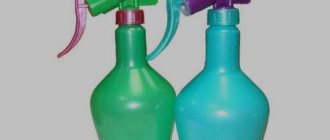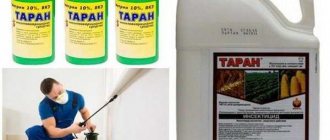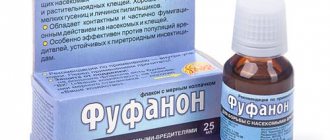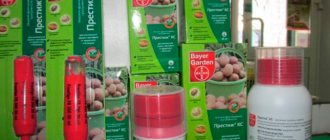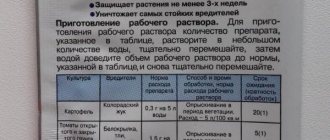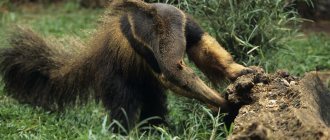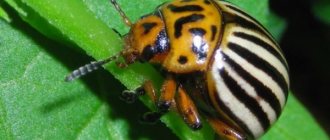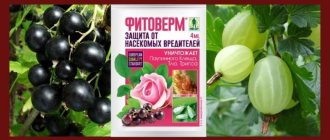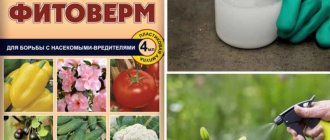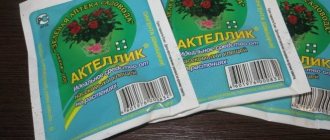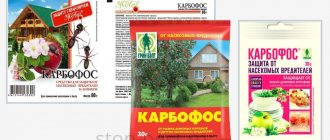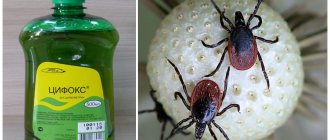Author: Elena N. https://floristics.info/ru/index.php?option=com_contact&view=contact&id=19 Category: Insecticides Published: March 30, 2012Republished: February 26, 2019Last edits: March 16, 2021
Among the huge number of universal products that destroy plant pests, the drug Kleshevit of JSC Firm August occupies a special place: it is an insectoacaricide, that is, it effectively fights not only harmful insects, but also mites, which, as is known, belong to arachnids.
Tick beetle - insecticide - composition, principle of action
The main component in the composition is aversectin C. This is a substance from the group of biological pesticides (avermectin class). This determines its low level of toxicity to plants. This component is a combination of different avermectins from the microorganism Streptomyces avermectilis. The active substance is characterized by a wide spectrum of action, as it destroys pests of various types, including:
- mites representing various families;
- Colorado beetle;
- caterpillars;
- aphid;
- thrips and others.
The tick is effective for several weeks, the duration of this period depends on environmental conditions, as well as on whether errors were made during processing. Moreover, protection on protected ground is provided for a longer period. This is due to the ability to create suitable conditions and maintain them.
The drug can be used to treat many garden crops
The active component begins to be released and act after 6-8 hours if the treatment was carried out in a greenhouse, and 8-10 hours in open ground. Such differences in the mechanisms of operation are due to the fact that the drug is more effective at high temperatures (such conditions are often created in greenhouses).
Aversectin C is characterized by contact-intestinal action. It penetrates the outer membranes of mites and other pests and also enters the digestive tract. These processes develop simultaneously, since the parasite first finds itself on the treated plant, soil, where it receives a dose of poison. Then it pierces the tissues of the plantings with its mouthparts.
At the same time, into the body of the parasite
an additional portion of the toxic substance enters, which increases the negative impact.
The active compound in the drug in question disrupts the functioning of the nervous system. Other means provide the same result, but Kleshchegon has the advantage of no toxic effects. When the nervous system is damaged, all functions in the body of a tick or other pest are disrupted. Because of this, parasites lose the opportunity to fully feed and reproduce.
As a result,
the number of pests first stops increasing, and soon begins to rapidly decrease.
This is due to 2 factors:
- no new offspring appear;
- pests die quickly.
Packaging of “Kleschegon” product
A female that has received a dose of poison will not be able to lay eggs, so the number of pests will not increase, even if some parasites are still found on the plants. First comes paralysis. Soon after this, the pest dies. You can get this result in just 2 days. Because the parasites can remain viable for a period after receiving a large dose of the poison, the remedy appears to be ineffective. However, you should wait a few days.
Soon
After treatment, pests will disappear from the area.
It is believed that aversectin C does not contribute to the development of resistance in parasites. However, just in case, to prevent the development of resistance in pests, it is better to periodically change Kleshchegon to another drug. This will allow you to use it for a long time without the risk of losing its properties in the fight against ticks.
Tick beetle can be used in conjunction with other insecticides. There are no restrictions. This feature is due to the absence of negative effects on plants and warm-blooded animals. Moreover, a product of this type can be used to protect plants of different types: vegetable, ornamental, fruit.
Depending on the environment, the effect of Kleshchogon can last several weeks.
Description
Tick beetle is an insecticide, a reliable preparation against insect pests. The product is used to protect fruit, ornamental, berry and vegetable crops. The substance does not cause resistance.
Active ingredient: Aversectin C, 10 g/l, emulsion concentrate.
Advantages:
– Higher concentration – lower application rate. Economically beneficial.
– Does not penetrate through plant membranes into the plant – does not accumulate in plants and fruits.
– Can be used at any phase of plant development, including during fruiting. Harmless to human health.
– At high temperatures, the effectiveness of the drug increases, whereas for most chemical drugs it decreases.
– Short waiting period – 2 days.
– Wide spectrum of action (spider mites, aphids, thrips, lepidopteran caterpillars, Colorado potato beetle, root-knot nematodes, etc.).
Period of protective action of the drug: 10-14 days.
Recommendations for use: In a bucket or any other vessel, the calculated amount of the drug is dissolved in a small volume of water with constant stirring. Then add water to the required volume per 100 sq.m. The working solution must be used on the day of preparation. Treatment is carried out during the growing season. After treatment, be sure to wash and dry the sprayer.
| Culture | Pest | Consumption rate, working fluid consumption, frequency of treatment, interval, waiting period |
| Potato | Colorado beetle | 2ml/10l of water, 5l/area, 1-3 treatments, 20 days, 2 days. |
| Cabbage | White moths, cutworms | 8ml/10l of water, 4l/bush, 1-3 treatments, 20 days, 2 days. |
| Currant | Spider mite | 4ml/10l of water, 1l/bush, No more than 2 treatments, 2 days. |
| Moths, leaf rollers | 3ml/10l of water, 1l/bush, One treatment, 2 days. | |
| Apple tree | Mites (spider mites, etc.), leaf beetles, moths | 3ml/10l of water, 2-4l/young tree, 5-8 liters for an adult tree, one treatment, 2 days. |
| Apple fruit, cutworms | 4ml/10l of water, 2-4l/young tree, 5-8 liters for an adult tree, one treatment, 2 days. | |
| Cucumbers, tomatoes, peppers, eggplants | Spider mite | 2ml/10l of water, 10l/area, 2-3 treatments, 20 days, 2 days. |
| Aphids (peach, melon) | 8-12ml/10l of water, 10l/area, 2-3 treatments, 15 days, 2 days. | |
| Thrips | 20ml/10l of water, 10l/area, 2-3 treatments, 15 days, 2 days. | |
| Protected soil roses | Spider mite | 4ml/10l of water, 10l/area, 2-3 treatments, 20 days, 2 days. |
| Green rose aphid | 8ml/10l of water, 10l/area, 2-3 treatments, 14-16 days, 2 days. | |
| California thrips | 16ml/10l of water, 10l/area, 2-3 treatments, 7 days, 2 days. |
Composition and principle of operation of the drug Kleschevit
Under one brand name “Kleschevit”, three different drugs are presented on the market, differing in purpose, active ingredients, and methods of application.
- Kleschevit Super Spray is a product created for household use that protects people from fleas and ixodid ticks. A solution of the active alphacypermethrin is sprayed onto clothing as a protective agent. Available for sale in 100 ml aerosol bottles.
- Kleschevit Super is a product designed to disinfect summer cottages from ixodid ticks. The active ingredient is highly concentrated cypermethrin. Emulsion concentrate is supplied in 100 ml bottles.
- Kleschevit is a biological insectoacaricide, the composition is based on the drug aversectin C, produced by the bacteria Streptomyces avermitilis. Designed to protect fruit and berry trees and shrubs, vegetable crops, garden ornamental and indoor plants from piercing, sucking and gnawing insect pests. Available in the form of an emulsion concentrate of 4 and 10 ml.
Both acaricides, Kleschevit Bio and Kleschevit Super, are nerve-paralytic poisons of contact-intestinal action. The impact begins after the substance enters the arthropod’s body. The poison, inhibiting the nervous system of the tick, causes paralysis.
Tick medicine - Kleschevit
Aversectin C begins to act within a few hours, complete destruction of pests occurs in 3-6 days. Aversectin C does not accumulate in plants or in the external environment. The product is not detected in fruits and leaves after three days; in the soil it disintegrates after 30 hours.
The action of cypermethrin is also quite fast, however, the half-life in the soil, depending on its type, occurs up to 12 months. At normal humidity, under the influence of sunlight on the grass, the substance decomposes within 2-3 weeks. Therefore, it is not recommended to treat plantings of cultivated plants with Kleschevit Super.
Kleschevit Super Spray
You need to treat clothes with prophylactic Kleschevit Super Spray (0.25% α-cypermethrin) outdoors, standing with your back to the wind and blowing a stream of the drug into the wind.
The spray can is held 20-25 cm from the clothing being treated so that with one press the product covers an area of approx. 1 sq. dm. Each area is sprayed once; You cannot “spray” the same place again. First of all, the places where ticks crawl towards the body are sprayed: the cuffs of trousers, the inside of the trouser legs and the waistband. If you are going to the infected area wearing boots, it will be useful to treat the legs of your trousers and the inside to the height of the boot tops. The treated clothes are dried outside in the breeze for a day. Wear it only to go to the infected area; You cannot wear treated clothing as casual or work clothes (except for inspecting areas to be treated with Kleschevit Super “simple”).
Under outerwear treated with Kleschevit Super Spray, be sure to wear underwear that completely covers the body: long johns, socks over long johns and an untucked sweatshirt. It is advisable to wear calico underwear or other fairly dense fabric that absorbs sweat well.
Note: a sweatshirt as underwear and a padded sweatshirt are different items of clothing. A sweatshirt is a long, almost knee-length T-shirt with long sleeves. It differs from a pajama jacket in the absence of a collar, pockets and fasteners.
Application of the drug Kleschevit for different crops
The drug Kleschevit Super, according to the instructions for use, is used to destroy ixodid ticks on a personal plot during the season when arthropod pests are active, immediately after the snow melts, but no more than twice. The break between treatments must be at least 14 days. Permanent stay of people is possible 3 days after disinfestation.
Kleschevit Super
Sanitation of the territory is carried out in calm weather and in the absence of precipitation, paying special attention to the outer sides of the site. The working solution is not stored, it is prepared immediately before use. The concentration is: 5 ml of the drug per 1-2 liters of water. This volume is enough to process 100 m². If the type of mites is unknown, then the consumption of the drug for the same volume of liquid increases to 12 ml.
Kleschevit Bio, as indicated in the instructions for use, is used in gardens and summer cottages to protect various plants from spider mites, red mites and hawthorn mites, as well as from aphids and nematodes. The effectiveness of the acaricide depends on the ambient temperature. At high rates, the rate of development of pests increases, and most of them fall under the influence of the acaricide. Therefore, the maximum effect of Kleschevit against spider mites is achieved at an air temperature of 30 to 32 ° C, in the range of 24-26 ° C the effect decreases, below 20 ° C the effect is minimal.
Expert opinion Oksana Aleksandrovna Ogorodnik with extensive experience. For me, gardening is more than just a hobby. The instructions for the drug Kleschevit also recommend when it is best to treat the plants. Spraying is carried out in dry weather, and the wind speed should not exceed 2-3 m/s. In the morning the procedure is carried out no later than 10 o’clock, in the evening from 18 to 22 o’clock. During the procedure, plant leaves are thoroughly wetted over the entire surface.
The manual for the product describes in detail how to dilute Kleschevit. Depending on the type of plant, the required application rate of the emulsion is dissolved in a small amount of water. Further, with constant stirring, the remaining liquid brings the volume to the required volume.
Treatment of stone fruit trees with Kleschevit
The drug is used to protect fruit trees from Schlechtendahl mites, spider mites and red mites. The first treatment is carried out no earlier than 3 days before the flowers begin to bloom; if pests are present, another disinsection is possible after flowering.
The spray solution is prepared by diluting 1.5 ml of the product in 1 liter of water. Depending on the age and variety, you will need from 2 to 5 liters of working fluid per tree.
Instructions for use
Tick-borne insects penetrate the pest's body upon contact with the solution - it is absorbed through the outer integument or after eating sprayed leaves in those places where the solution has entered. The drug is used to protect garden flowers, berries, fruit bushes and vegetables, as well as indoor plants, not only from ticks, but also from a number of other pests:
- flower thrips
- scale insects
- scale insects
- Colorado beetle
- aphids
- leafrollers
- weevil
- codling moth
- scoops
- cabbage and turnip whites
- cabbage moth
Important: mite beetle is not very effective against scale insects and scale insects, and is completely useless against soil pests!
Storing the working solution is not allowed! The solution must be used within an hour after dilution.
Release form, varieties of Kleschevit
The drug Kleschevit is produced domestically in the form of a concentrated emulsion. Immediately before use, prepare a solution by dissolving the product in cold water. Contains a slight specific odor. Acts on the basis of aversectin C.
The drug should be stored away from direct sunlight. Shelf life – 2 years from the date of manufacture. The prepared solution should be used within 24 hours. Subsequently, the product loses its properties.
Another effective drug is Kleschevit super 100 ml. The insectoacaricidal agent is based on cypermethrin. It is produced in the form of a concentrate and has a distinct, specific odor. To prepare the solution, the emulsion must be dissolved in the required amount of cool water. Use within 3 days.
The shelf life of the concentrate is 3 years from the date of manufacture. The bottle should not be left in a sunny place. After the first use, it is recommended to use the concentrate for 12 months.
Consumption rates
Prepare a solution in warm water, this is how the manufacturer recommends diluting the drug:
- Potatoes against the Colorado potato beetle: 1 ml per 1 liter of water, spraying during the growing season, with an interval of 20 days (consumption: 5 liters per 100 sq. m.) 1-3 times
- Cabbage from cabbage whites, turnip whites, cabbage moths: 4 ml per 1 liter of water - spray twice (consumption: 4 liters per 100 sq. m.)
- Currants against mites: 2 ml of mite per 1 liter of water - spraying during the growing season (consumption: 1 liter per bush), twice at intervals of 5-7 days
- Currants from moths, leaf rollers: 1.5 ml per 1 liter of water
- Apple tree against spider and red fruit mites, Schlechtendahl mite, leaf roller, moth: 1.5 ml per 1 liter of water - spray twice at a rate of: 2-5 liters per 1 tree
- Apple tree against codling moth and cutworm: 2 ml per 1 liter of water, once 2-5 liters per 1 tree
- Cucumbers, peppers, eggplants for ticks: 1 ml per 1 liter of water - spray twice with an interval of 20 days, consumption: 10 liters per 100 sq. m., you can spray cucumbers and peppers during flowering
- Cucumbers, peppers, eggplants from peach and melon aphids: 4-6 ml per 1 liter of water, spraying two to three times, with an interval of 15 days, at a consumption of: 10 liters per 100 sq. m. m
- Cucumbers, peppers, eggplants from tobacco, Californian thrips: 10 ml per 1 liter of water - spraying two to three times, with an interval of 20 days
- Tomatoes in greenhouses against mites: 1 ml of mite per 1 liter of water - spraying twice, with an interval of 20 days, at a consumption of 10 liters per 100 sq. m. m, you can spray tomatoes during flowering
- Tomatoes in greenhouses from peach and melon aphids: 4-6 ml per 1 liter of water, spraying two to three times, with an interval of 15 days
- Tomatoes in greenhouses against thrips: 10 ml per 1 liter of water - spraying two to three times, with an interval of 20 days
- Houseplants and garden flowers (for example, roses) from spider mites: 2 ml per 1 liter of water - spraying when a pest is detected, two or three times with an interval of 7-10 days
- Houseplants and garden flowers from rose aphids: 4 ml per 1 liter of water - spraying when a pest is detected, two or three times with an interval of 14-16 days
- Houseplants and garden flowers against thrips: 8 ml per 1 liter of water - spraying during the flowering period two to three times with an interval of 7 days
Comments from iplants.ru: the indicated treatment periods (intervals between sprayings) are indicated to control the pest. It is assumed that on garden flowers, fruit trees and shrubs, vegetables, spraying against pests will never achieve 100% destruction; treatments are needed to prevent the plants from weakening before flowering or fruiting and to accumulate enough strength for the winter. At home, the gardener has one goal - to completely get rid of mites, thrips or other pests once and for all. Therefore, we recommend repeat spraying against ticks twice with an interval of maximum 3 days, then change the drug.
In addition, it is necessary to take into account the individual development cycles of the pest: the period of maturation - from egg to larva it can take 3 days, maybe 7 or 10, it depends on the type of pest and on the temperature. Thus, thrips eggs mature in 6-7 days, feed on leaves for about a week, then go deep into the soil to complete development into adult flying individuals. Therefore, for thrips, the spraying interval is 6 days.
The instructions do not indicate the use of kleschevit against the strawberry mite, but it can be used, especially when strawberries are already filled with berries and other chemicals cannot be used. Mites on strawberries from the strawberry mite: 6-10 ml per 1 liter of water, frequency of treatments - three times every three days, spray only at a temperature not lower than 24°C
Resistance
Manufacturers claim that pests do not become accustomed to preparations based on aversectin C, so it can be used for several years in a row. This is outdated information, resistance exists, but it depends on the frequency of use of the drug and the type of pest. For example, scientists have discovered that red spider mite populations are extremely resistant to the drugs Kleschevit, Fitoverm and Vermitek.
Reviews
Inga: unfortunately, the drug does not affect eggs and larvae of younger pests. And the drug will also not reach adult mites hidden in the leaf axils. This is the main drawback of Kleschevit.
Andrey: Kleschevit’s effect is approximately the same as that of Fitoverm, but it seemed to me that it was a little weaker. But Kleschevit is not very toxic and quickly disintegrates without poisoning the soil, air, water and plants.
Gardener: The drug Kleschevit is inexpensive and dissolves easily. I treated the rose for spider mites, but at first I didn’t notice any changes. I took a magnifying glass and carefully examined the bush: I didn’t find any ticks. Then the leaves gradually fell away.
Official website and manufacturer's recommendations: https://dacha.avgust.com/catalog/kleshchevit/
- How to use Decis Profi in the garden
Tank mix compatibility
Kleschevit is compatible with insecticides from the classes of organophosphates (fufanon, actellik) or pyrethroids (talstar), and each drug should be used in a dosage half the recommended one. Mite mite is incompatible with the insecticide Vermitec (same class of avermectins). It is advisable to use mite mite in alternation with drugs of biological origin, such as bitoxibacillin.
Also, mite mite is compatible with any growth regulators (zircon, epin, ribav-extra) and fungicides that do not form an alkaline solution reaction.
List of drugs based on clopiralide
Many agricultural companies package this herbicide and sell it under different trade names:
- Clorite;
- Lorgnette;
- Gazontrel;
- Longan;
- Bis-300;
- Lonner-Euro;
- Clippard;
- Choice-300;
- Hacker;
- Premier-300;
- Tatrel-300;
- Lontrel-300.
Registration of some drugs expires in 2022 – 2020.
Toxicity
Kleshchevit has a hazard class 3 (moderately dangerous substance), hazard class 2-3 for bees (class 2 in an increased dosage of dilution against aphids). Tick beetle is not phytotoxic.
Security measures
Handle using gloves. While working, you must not smoke, drink, or eat. After work, wash your face and hands with soap and rinse your mouth. Store the drug in a cool, dry room at a temperature from -20C to +30C, separate from food and medicine, out of the reach of children and pets! There is no antidote; treatment for ingestion is symptomatic.
Advantages
- Higher concentration – lower consumption rate. Economically beneficial;
- Does not penetrate through plant membranes into the plant - does not accumulate in plants and fruits;
- Can be used at any phase of plant development, including during fruiting. Harmless to human health;
- At high temperatures, the effectiveness of the drug increases, while that of most chemical drugs decreases;
- Short waiting period – 2 days;
- Wide spectrum of action (spider mites, aphids, thrips, lepidopteran caterpillars, Colorado potato beetle, root-knot nematodes, etc.). Higher concentration - lower consumption rate. Economically beneficial;
- Does not penetrate through plant membranes into the plant - does not accumulate in plants and fruits; m
- Can be used at any phase of plant development, including during fruiting. Harmless to human health;
- At high temperatures, the effectiveness of the drug increases, while that of most chemical drugs decreases;
- Short waiting period – 2 days;
- Wide spectrum of action (spider mites, aphids, thrips, lepidopteran caterpillars, Colorado potato beetle, root-knot nematodes, etc.).
Precautionary measures
The product belongs to the third hazard class, and is therefore considered a moderately dangerous substance. It has no phytotoxic properties, but is dangerous for fish. Therefore, the substance must not be allowed to enter the reservoir.
Expert opinion
Zarechny Maxim Valerievich
Agronomist with 12 years of experience. Our best country expert.
Ask a Question
For bees, the composition poses a moderate danger and belongs to the second class of toxicity. During the flowering period, it is prohibited to process the plantings.
To prepare the working solution, it is prohibited to use food utensils. Plantings must be processed in the absence of children and animals. It is recommended to use goggles, protective clothing, a respirator, and gloves. The protection of bees and other beneficial insects is of no small importance.
See also
Instructions for use of Sidopride, dosage of the disinfectant and analoguesRead
After work, it is recommended to wash your face and hands. It is also worth rinsing your mouth. If the composition gets into your eyes or skin, rinse them with water. In case of accidental ingestion of the drug, it is necessary to take several glasses of activated carbon solution. To do this, you need to take 5-6 tablets per glass. After this, it is recommended to induce vomiting and consult a doctor.
Mechanism of action
Tick tick repellent based on aversectin C is a biological preparation. It begins to act immediately, but the effect is noticeable after 5-7 days. The active substance has insecticidal properties and disrupts the functioning of the nervous system of insects. It enters the body of ticks during feeding. The rate of death depends on the accumulated amount of toxic substance. The spider mite dies within a week.
The drug Kleschevit against ticks
Kleschevit super is a toxic drug based on cypermethrin (25%). Destroys parasites in 2 hours, remains active indoors for 20 days, outdoors for 20 days. It enters the body of ticks upon contact through the chitinous cover, during feeding. Provokes muscle paralysis in 5 minutes. Mass death of pests occurs within 30 minutes.
Recommendations
- The occurrence of resistance is unlikely, but it is recommended to alternate with insecticides and acaricides from other chemical groups.
- It should be borne in mind that the effect of the drug largely depends on the air temperature. When it decreased from 24 to 17°C, the toxicity for the common spider mite decreased by 7.6 times, and when it increased to 32°C it increased by 4.8 times.
- The drug "Kleschevit, EC" is a complete analogue of "Fitoverm, EC", only with a concentration of the active substance 2.5 times less, so when choosing, it is better to give preference to the latter.
special instructions
While working with Kleschevit preparations, it is forbidden to eat, drink or smoke. Immediately after spraying crops, wash your hands with soap and wash. When an insecticidal agent gets on the skin, an allergic reaction occurs, and intoxication of varying degrees of severity occurs in the respiratory tract.
It is forbidden to work with toxic substances for pregnant women, lactating women, people prone to allergies, respiratory diseases, or breathing difficulties.
If, during the process of spraying plants against ticks, dizziness, nausea, weakness, or headache occur, work should be stopped. Rinse your mouth with a soda solution, take activated carbon at the rate of 1 tablet per kilogram of weight. If the condition does not return to normal, you need to seek help from specialists.
Kleschevit super is used to treat areas against ixodid ticks. Destroys adults, nymphs, larvae of different ages. Protection after one spraying lasts 20 days. Disinsection is carried out wearing gloves, a respirator, and a protective suit.
The importance of following safety precautions
When using the prepared solution, you should be very careful with the product, therefore, if it comes into contact with the skin, eyes, or accidentally inhales the drug, you must immediately provide first aid. In some cases, even call a doctor.
If Kleschevit gets on the skin, it should be removed with cotton wool without rubbing. Then rinse the area with water. When the product gets into your eyes, rinse them thoroughly under running water, keeping them open. In case of accidental inhalation, immediately change into clean clothes, go out into fresh air and call a doctor immediately. Under no circumstances should you self-medicate!
There are cases when Kleschevit gets into the digestive tract due to careless handling. Before going to the medical center, the first thing you need to do is rinse your mouth and drink activated carbon based on one gram of sorbent per 1 kg of the victim’s weight. Then induce vomiting and, if necessary, repeat the entire process and also visit a doctor.
